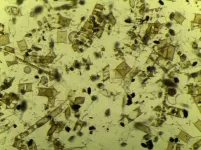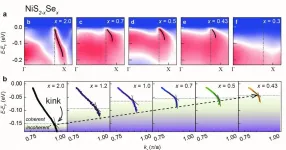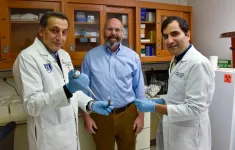(Press-News.org) Scientists have pinpointed the location of an essential enzyme in plant cells involved in photosynthesis, according to a study published today in eLife.
The findings overturn conventional thinking about where the enzyme resides in plant cells and suggest a probable role in regulating energy processes as plants adapt from dark to light conditions.
During photosynthesis, plants convert carbon into energy stores through 'electron transport', involving an enzyme called ferredoxin:NADP(H) oxidoreductase, or FNR.
Plants can switch rapidly between two types of electron transport - linear electron flow (LEF) and cyclic electron flow (CEF) in response to environmental conditions. The transfer of FNR between membrane structures in the chloroplast, where photosynthesis takes place, has been linked to this switch.
"Current dogma states that FNR carries out its function in the soluble compartment of the chloroplast, but evidence suggests that the activity of FNR increases when it is attached to an internal membrane," explains first author Manuela Kramer, a PhD student at the School of Biological and Chemical Sciences, Queen Mary University of London, UK. "We needed to find out precisely where FNR is located in the chloroplast, how it interacts with other proteins, and how this affects its activity in order to understand its role in switching between electron transport processes."
The researchers used immuno-gold staining to pinpoint FNR in more than 300 chloroplasts from 18 individual Arabidopsis plants. The staining density of FNR was five times higher in the internal membrane system of the chloroplast (thylakoids) than in the soluble compartment (stroma), where it did not rise above background levels. This significantly higher labelling in the membrane proved that chloroplasts contain little soluble FNR, and confirmed for the first time where the enzyme is located.
To understand more about FNR's location, the team generated plants where the enzyme is specifically bound to different proteins called 'tether proteins'. In Arabidopsis plants with decreased FNR content, they substituted three versions of FNR from maize, each with a different capacity for binding to the tether proteins TROL and Tic62. They found that rescue with maize FNR types that strongly bound to the Tic62 tether protein resulted in much higher density of gold FNR labelling in specific, lamellar membrane regions of the thylakoids. This suggests that the distribution of FNR throughout the chloroplast in plant cells is dependent on binding to the tether proteins.
Finally, the team tested how FNR location affects electron transport, by comparing electron flow rates when plants were adapted to the dark with electron flow after their acclimatisation to light. In normal dark-adapted plants, a short exposure to light resulted in a switch to higher CEF activity. However, this was not seen in plants lacking strong interaction between FNR and the tether proteins, suggesting these plants lack the ability to switch on CEF. After light acclimatisation, both the wild-type and mutant plants had similar, decreased CEF activity, suggesting that the impact of FNR is related to light-dependent changes in the interactions between the enzyme and tether proteins.
"Our results show a link between the interaction of FNR with different proteins and the activity of an alternative photosynthetic electron transport pathway," concludes senior author Guy Hanke, Senior Lecturer in Plant Cell and Molecular Biology at the School of Biological and Chemical Sciences, Queen Mary University of London. "This supports a role for FNR location in regulating photosynthetic electron flow during the transition of plants from dark to light."
INFORMATION:
Media contact
Emily Packer, Media Relations Manager
eLife
e.packer@elifesciences.org
+44 (0)1223 855373
About eLife
eLife is a non-profit organisation created by funders and led by researchers. Our mission is to accelerate discovery by operating a platform for research communication that encourages and recognises the most responsible behaviours. We aim to publish work of the highest standards and importance in all areas of biology and medicine, including Plant Biology, while exploring creative new ways to improve how research is assessed and published. eLife receives financial support and strategic guidance from the Howard Hughes Medical Institute, the Knut and Alice Wallenberg Foundation, the Max Planck Society and Wellcome. Learn more at https://elifesciences.org/about.
To read the latest Plant Biology research published in eLife, visit https://elifesciences.org/subjects/plant-biology.
Author contact details for more information: Guy Hanke, senior author (Queen Mary University of London, UK) - g.hanke@qmul.ac.uk
Full list of funders for this study:
Deutsche Forschungsgemeinschaft, Biotechnology and Biological Sciences Research Council, University Grenoble Alpes graduate school, European Research Council, LabEx Saclay Plant Sciences-SPS, French Infrastructure for Integrated Structural Biology, Bayer CropScience
Grant numbers:
BB/R004838/1, ANR-10-LABX-49-01, ANR-10-LABX-0040-SPS, ANR-10-INSB-05, F-2016-BS-0555
Gas and liquid separation processes in the chemical industry could be made more efficient and environmentally friendly by using substances known as intrinsically porous materials (IPMs). KAUST researchers review the prospects for IPMs in the journal Accounts of Chemical Research.
Niveen Khashab and her team are currently heavily involved in IPM research. "We focus on making materials that will have an impact on the chemical and petrochemical industries in Saudi Arabia and the world," says Niveen Khashab, the corresponding author of the review.
IPM materials can separate gases and liquids without using traditional ...
The annually occurring algal spring blooms play an important role for our climate, as they remove large amounts of carbon dioxide from the atmosphere. However, they are an ephemeral phenomenon. Most of the carbon is released into the water once the algae die. There, bacteria are already waiting to finish them off and consume the algal remains.
Previous studies have shown that in these blooms, different algae can come out on top each year. However, within the bacteria subsequently degrading the algae, the same specialised groups prevail year after year. Apparently not the algae themselves but rather their components ...
According to an international study published in Frontiers in Psychology, people around the world have reported changes in their physical activity levels, wellbeing, and eating habits during the first stages of the COVID-19 pandemic. A decrease in physical activity during the pandemic was associated with poorer perceived physical and mental health. Reduced exercise was also associated with perceptions of weight gain and decreased sleep.
More than a thousand individuals from several countries with different containment measures participated in an online survey that explored changes in physical activity, eating, sleep, physical and mental health, and wellbeing during the first lockdown phases ...
A RAND Corporation report funded by The Rockefeller Foundation shows that COVID-19 testing can be effectively integrated into K-12 schools' pandemic response plans, helping families and staff feel more comfortable with in-person instruction.
The report found that even for well-resourced districts and schools, launching a COVID-19 testing program was a major undertaking that required access to rapid-turnaround tests, additional staffing or strong partners for logistical support, technical assistance for the design and execution of testing programs, and a strategy for successfully engaging the school community to participate ...
Adding a simple polymer to fertilizers or pesticides could dramatically reduce agricultural pollution, suggests a new study by researchers at the University of British Columbia.
When agrochemicals are sprayed onto crops, a large amount typically ends up in the surrounding environment due to droplets splashing, rebounding or rolling off the target plants.
This amount could be cut at least in half by mixing fertilizers and pesticides with a small quantity of polyethylene oxide, a common polymer additive that improves the ability of agrochemical solutions to stick to plant surfaces, ...
CORVALLIS, Ore. - A quarter-century-old harvesting restriction intended to last one year has served as an obstacle to returning eastern Oregon national forests to the healthier, more fire-resilient conditions they embodied in the late 1800s, research by the Oregon State University College of Forestry shows.
The findings, published in Ecosphere, are both important and timely because the U.S. Forest Service recently revised what has widely become known as the "21-inch rule" - a prohibition against cutting trees greater than 21 inches in diameter at breast height on Forest Service land in eastern Oregon.
"Under the old policy, live trees more than 21 inches in diameter ...
Strongly correlated systems are materials that exhibit strong interactions between electrons, a property unseen in ordinary conductors or insulators. Typical examples include metal-insulator transitions or unconventional high-temperature superconductivity where the resistance becomes zero at high temperatures.
There have been studies to explain this strong interaction between electrons and their characteristic energy scales, but no direct observation on such energy scales through theory or experiments has been reported. To this, the POSTECH-IBS joint research team has succeeded in directly observing the evolution of coherence energy ...
WASHINGTON--Illegal use of anabolic steroids not only has dangerous side effects during use but also can harm of men's testicular function years after they stop abusing steroids, according to a study published in the Endocrine Society's Journal of Clinical Endocrinology & Metabolism.
Anabolic steroids are synthetic forms of testosterone, and their abuse is prevalent among athletes worldwide. Some people use these steroids without a prescription to improve athletic performance or get a more muscular look. Known side effects of these drugs in men include breast growth, hair loss, shrunken testicles and lower testosterone levels. Also called hypogonadism, low testosterone can cause decreased sex drive, poor erections and a low sperm count.
"It is still debated whether illicit ...
A worryingly high number of Asian bamboo longhorn beetles (Chlorophorus annularis) turn out to have been emerging across Europe for about a century already, finds an international research team, headed by researchers from the Center of Natural History, University of Hamburg, Germany. Curiously, the recent records of the invasive, non-native to the Old Continent species are mostly sourced from citizen scientists and online platforms, which proves the power of involving the public in species monitoring. The study is published in the open-access, peer-reviewed ...
A two-week course of high doses of CBD helps restore the function of two proteins key to reducing the accumulation of beta-amyloid plaque, a hallmark of Alzheimer's disease, and improves cognition in an experimental model of early onset familial Alzheimer's, investigators report.
The proteins TREM2 and IL-33 are important to the ability of the brain's immune cells to literally consume dead cells and other debris like the beta-amyloid plaque that piles up in patients' brains, and levels of both are decreased in Alzheimer's.
The investigators report ...





